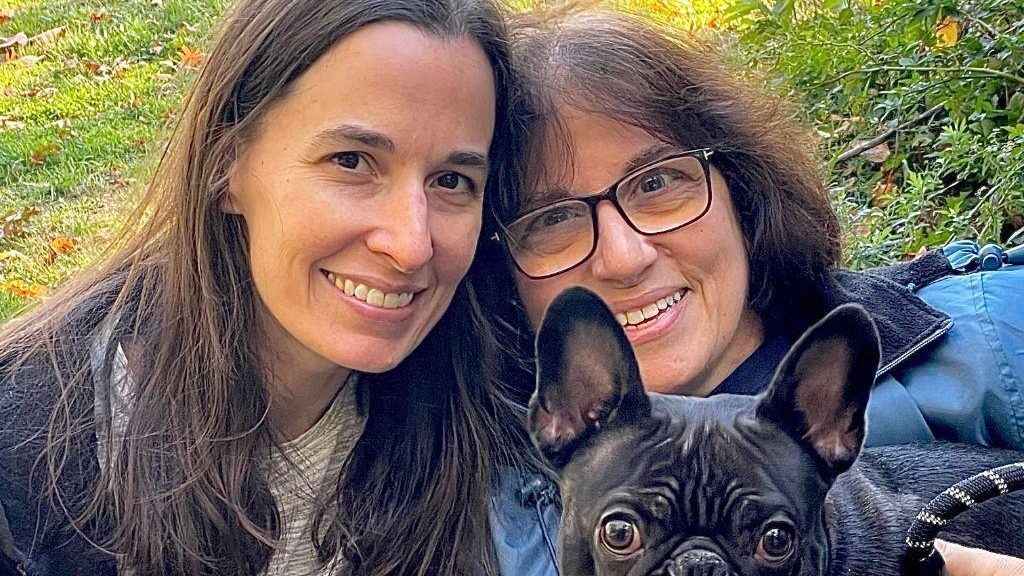EMPATHY AS A SERVICE
An interesting thing happens when analyzing how patients and their caregivers communicate and collaborate with healthcare professionals, when we study the nature of the conversation within a care team.
There are numerous healthcare services put forward by a care team: scheduling checkups, assessing progress, answering questions, educating, — but one stands out: empathy.
Merriam-Webster defines empathy as follows:
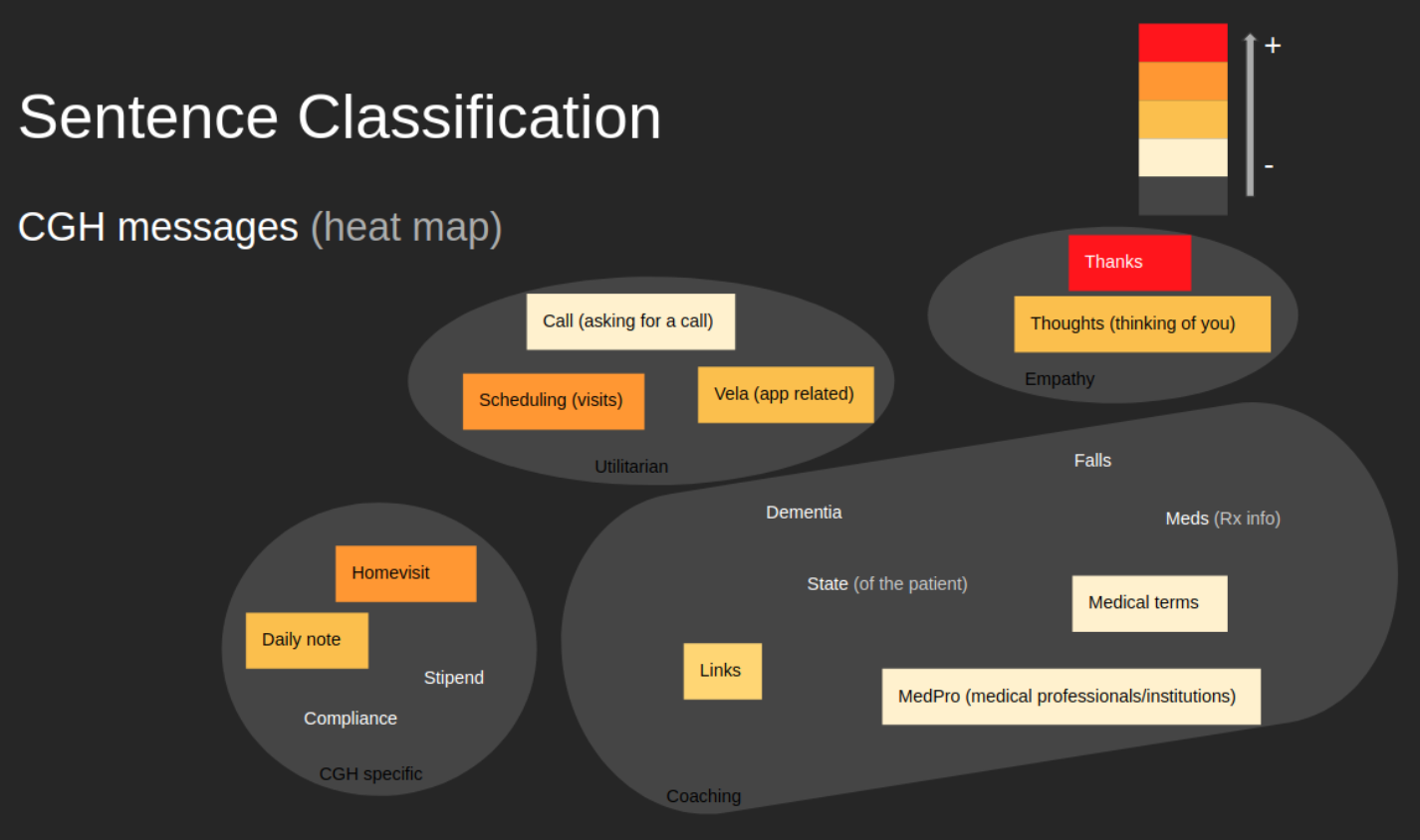 And here are the percentages per topic classified (not all topics are presented here but the percentages across all topics sum to 100).
And here are the percentages per topic classified (not all topics are presented here but the percentages across all topics sum to 100).
 The topic labeled “thanks”, with sentences containing word stems such as “thank”,”great”,”bless” and the topic “thoughts”, with sentences containing stems such as “sorry”,”prayers”, ”luck” accounted for over 28% of sentences analyzed. Worth noting that any one sentence could carry multiple topic classifications.
Another health care organization, Rhode Island Primary Care Physicians Corporation (RIPCPC) showed the same propensity for empathetic messages within care teams. RIPCPC is an “accountable care organization”, it is both a provider (physicians) and a payer (insurer) using Vela for care collaboration.
Here again we see the heat map with the empathy classification category in the upper-right classification cluster. Not the “coaching” cluster topics are more prevalent in this organization.
The topic labeled “thanks”, with sentences containing word stems such as “thank”,”great”,”bless” and the topic “thoughts”, with sentences containing stems such as “sorry”,”prayers”, ”luck” accounted for over 28% of sentences analyzed. Worth noting that any one sentence could carry multiple topic classifications.
Another health care organization, Rhode Island Primary Care Physicians Corporation (RIPCPC) showed the same propensity for empathetic messages within care teams. RIPCPC is an “accountable care organization”, it is both a provider (physicians) and a payer (insurer) using Vela for care collaboration.
Here again we see the heat map with the empathy classification category in the upper-right classification cluster. Not the “coaching” cluster topics are more prevalent in this organization.
 Notice that the relative percentage of empathetic classification is comparable between the two organizations (28%-30%). This is significant: across hundreds of thousands of sentences classified, across 2 entire separate health care organizations, in different geographical regions, roughly 30% of messages are empathetic within each organization once users have on-boarded.
Notice that the relative percentage of empathetic classification is comparable between the two organizations (28%-30%). This is significant: across hundreds of thousands of sentences classified, across 2 entire separate health care organizations, in different geographical regions, roughly 30% of messages are empathetic within each organization once users have on-boarded.
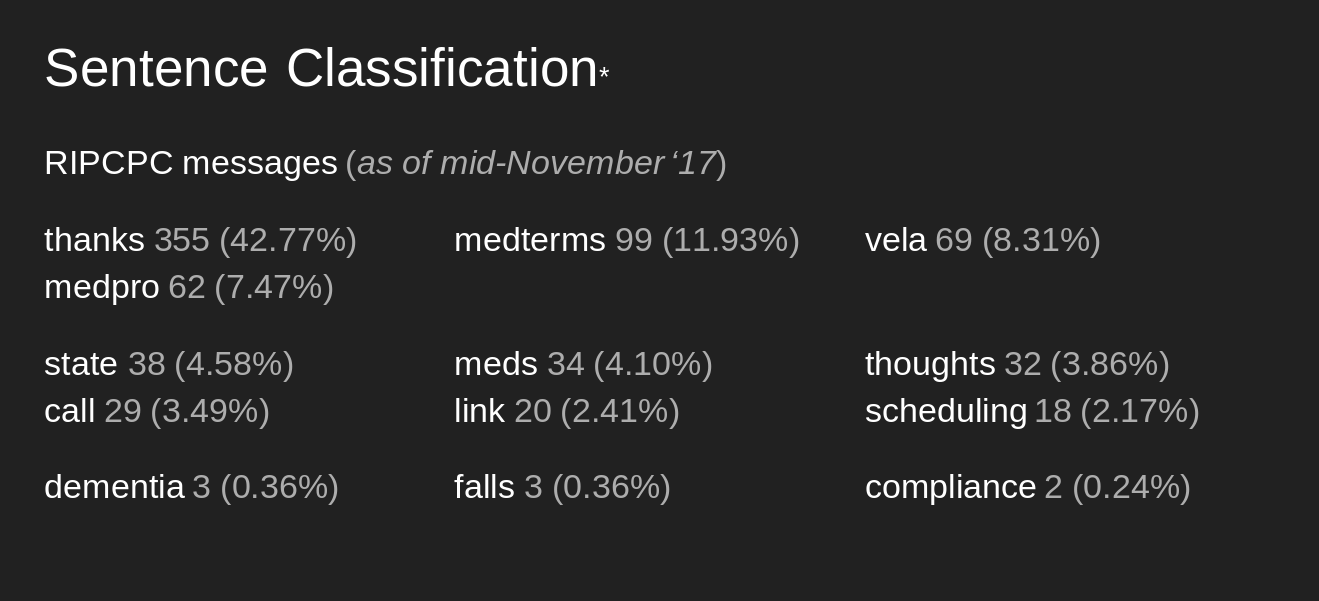 Several months later:
Several months later:
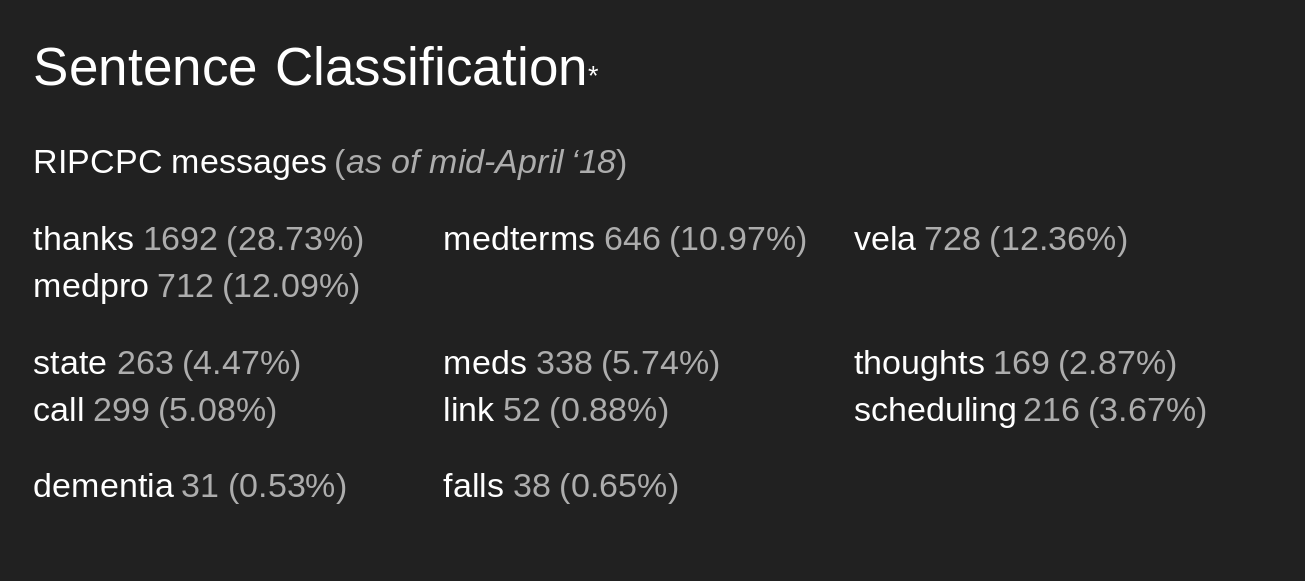 The initial roll-out period shows nearly half of all messages classifying in the empathy cluster (labels: “thanks” and “thoughts”). This is the period of establishing or re-establishing trust in the new medium of secure messaging.
Empathy is how health care professionals build and maintain lines of communication, how they build trust. It’s tribal knowledge among nurses and care managers.
The initial roll-out period shows nearly half of all messages classifying in the empathy cluster (labels: “thanks” and “thoughts”). This is the period of establishing or re-establishing trust in the new medium of secure messaging.
Empathy is how health care professionals build and maintain lines of communication, how they build trust. It’s tribal knowledge among nurses and care managers.
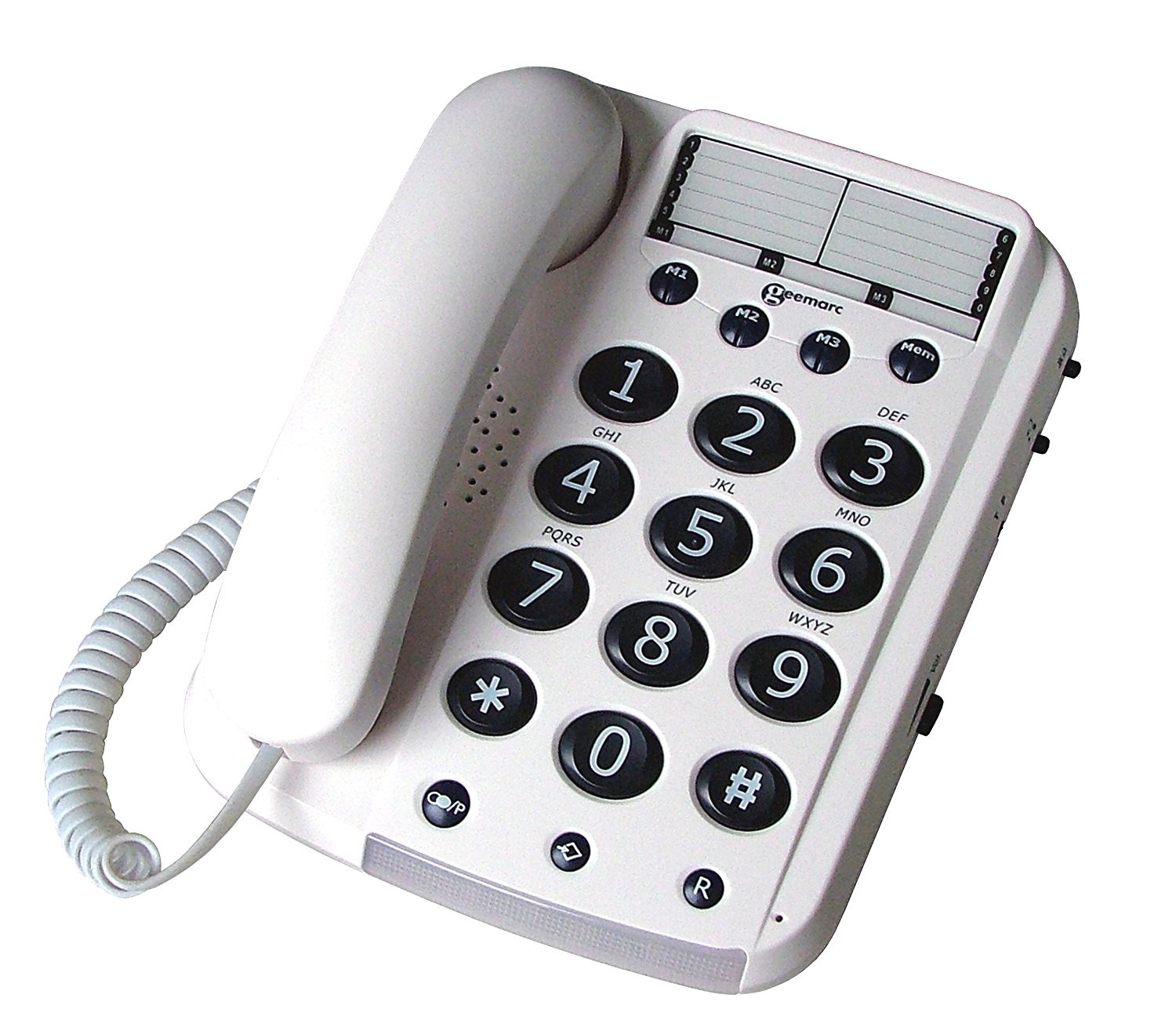 Once online communication is coupled with ongoing office visits and phone calls, we can measure empathy, compare empathetic scores between care teams, analyze the impact of empathy across incidents and risk.
Empathy as a service is a possibility today, but first we must take care communication out of the stone age.
Once online communication is coupled with ongoing office visits and phone calls, we can measure empathy, compare empathetic scores between care teams, analyze the impact of empathy across incidents and risk.
Empathy as a service is a possibility today, but first we must take care communication out of the stone age.
*References:
The action of understanding, being aware of, being sensitive to, and vicariously experiencing the feelings, thoughts, and experience of another of either the past or present without having the feelings, thoughts, and experience fully communicated in an objectively explicit mannerWe’ve heard about health care firms focusing on empathy to keep people healthier, including the Cleveland Clinic, and others. Studies confirm an association between a provider’s level of empathy and favorable clinical outcomes. Positive patient satisfaction and lower litigation rates are evidenced by patients who consider their providers to be empathetic*. Empathy is a fundamental building block of establishing trust between patients, their caregivers and healthcare professionals.
Empathy is a fundamental building block of establishing trust between patients, their caregivers and healthcare professionals.As we were building Vela, we studied the conversation between care professionals and family caregivers helping patients. The patients were often elderly or disabled and low-income members covered by Medicaid insurance. What we expected was a heavy dose of what Clayton Christensen referred to as “institutional knowledge” in the book “The Innovator’s Prescription”: for example “every 6 months check a specific biometric”. What we found instead, especially early on, was a highly empathetic and ‘soft’ discourse to establish and build trust. We realized that the formulaic medical dialogue typical of assessments and clinical guidance was often restrained until a certain level of basic trust had been established. Healthcare professionals, often trained nurses and social workers, instinctively understood that trust is elemental for administering care and that the nature of dialogue to engender trust is empathetic. This makes complete sense. Over time we’re seeing empathy as the most consistent form of discourse in the care team dialog.
Analyzing the Conversation
We built a text classification algorithm, the details of which can be reviewed here, and analyzed care team dialog across two separate health care organizations. The organizations don’t overlap in any way, although the model of care teams collaborating with patients and their family caregivers creates a similar setting. This is a trend in healthcare that is getting attention as the baby-boomer population forces increased efficiencies. The first healthcare organization studied was Caregiver Homes, an NCQA accredited service for high-risk elderly and disabled Medicaid patients. The service centers around home visits that are scheduled monthly and a “daily note” that the family caregiver enters each day to report on the patient’s health. This service keeps elderly patients out of nursing homes and allows to remain at home under the care of a family member, who receives a stipend for her work. Nearly a quarter million sentences within care team chat streams were analyzed, producing a heat map shown below. The most common classification topic identified was “Thanks” (basic empathy). Here are a few samples of thankful messages in the care team. Often these are initiated by the patient or their caregiver.'Hello Kathryn, Thank you for taking the time to meet with me and Sharon today.', 'Awww thank you, that is great to hear.', 'It was great meeting you ladies and I also look forward to working with you.', 'Hi, Jill Thank you for taking the time to meet with me and Sharon today.', 'Hi Barbara, Hope you are having a good day.', 'Hi Jackie-thanks for checking with me!', 'Thank you', 'Have a great day!', 'Good Morning John & Carol , Just wanted to check in .', 'Wonderful!', 'Hello Angel I just wanted to say thank you for coming by and checking on me today.', 'I was having such a horrible morning and for you to come to me and help me the way you did I had to say thank you!', 'i am glad i have you by my side and for the first time in a few days i feel less depression and mentaly everywhere so thank you again you are definitely my angel!', 'Good morning Eric, my name is Jackie, I am your patient advocate.', "Haven't gone for a walk yet but I will have a patch on today have a great day",And a few more empathetic messages, the sort often coming from healthcare professionals on the care team.
'Wishing you the best of luck with everything.', "Sorry, helping dad in the yard, he's an animal with a whip !", 'I am glad I can be here for you.', 'Just a reminder that we are here for you.', 'No problem , if you need to talk to someone, just know I am here for you.', 'I am so sorry that you are even going thru that Jill.', "Hello Allen, I'm sorry to hear about problem with your leg and that your hip surgery has been postponed.", 'Sorry to hear she is in the hospital.', 'Hey Susan, sorry so late but important news.', 'Sorry to hear that, however, I am glad you are feeling better!', 'Sorry Stephen, That last line should read keep A1C <7', 'sending positive thoughts for the day!', 'Yes, we are all lucky to have Angel on our team.', 'Good Afternoon Jody, I am sorry to hear that.', "Oh my, I'm sorry to hear you're having such an awful time.", 'I hope we get lucky and find the right situation.', 'Sorry to hear-you took the meds?', "Hi Josh and Ryan, So sorry to hear about your grandmother's recent complications.", 'Hi Annie, so sorry to hear about your boiler troubles but glad you made it to a warm place.', 'I am here for you, if you have any questions/concern, Sharon, RN',As you can see, the coaching category is broad and covers many topics, but none of them rises above the middle of the scale, whereas empathetic messages are in the high end of the scale. A heat map of this classification shows empathy topics (upper-right cluster) with the highest relative ‘heat’.
 And here are the percentages per topic classified (not all topics are presented here but the percentages across all topics sum to 100).
And here are the percentages per topic classified (not all topics are presented here but the percentages across all topics sum to 100).
 The topic labeled “thanks”, with sentences containing word stems such as “thank”,”great”,”bless” and the topic “thoughts”, with sentences containing stems such as “sorry”,”prayers”, ”luck” accounted for over 28% of sentences analyzed. Worth noting that any one sentence could carry multiple topic classifications.
Another health care organization, Rhode Island Primary Care Physicians Corporation (RIPCPC) showed the same propensity for empathetic messages within care teams. RIPCPC is an “accountable care organization”, it is both a provider (physicians) and a payer (insurer) using Vela for care collaboration.
Here again we see the heat map with the empathy classification category in the upper-right classification cluster. Not the “coaching” cluster topics are more prevalent in this organization.
The topic labeled “thanks”, with sentences containing word stems such as “thank”,”great”,”bless” and the topic “thoughts”, with sentences containing stems such as “sorry”,”prayers”, ”luck” accounted for over 28% of sentences analyzed. Worth noting that any one sentence could carry multiple topic classifications.
Another health care organization, Rhode Island Primary Care Physicians Corporation (RIPCPC) showed the same propensity for empathetic messages within care teams. RIPCPC is an “accountable care organization”, it is both a provider (physicians) and a payer (insurer) using Vela for care collaboration.
Here again we see the heat map with the empathy classification category in the upper-right classification cluster. Not the “coaching” cluster topics are more prevalent in this organization.
 Notice that the relative percentage of empathetic classification is comparable between the two organizations (28%-30%). This is significant: across hundreds of thousands of sentences classified, across 2 entire separate health care organizations, in different geographical regions, roughly 30% of messages are empathetic within each organization once users have on-boarded.
Notice that the relative percentage of empathetic classification is comparable between the two organizations (28%-30%). This is significant: across hundreds of thousands of sentences classified, across 2 entire separate health care organizations, in different geographical regions, roughly 30% of messages are empathetic within each organization once users have on-boarded.
Measuring Empathy Scores
We also wanted to see how empathy carried the conversation over time. When we examined the classification over time we see that empathetic messages were most prominent at the beginning of the roll-out of the care team communication solution. Classification of messages within text-based care team communication after a few initial months of roll-out: Several months later:
Several months later:
 The initial roll-out period shows nearly half of all messages classifying in the empathy cluster (labels: “thanks” and “thoughts”). This is the period of establishing or re-establishing trust in the new medium of secure messaging.
Empathy is how health care professionals build and maintain lines of communication, how they build trust. It’s tribal knowledge among nurses and care managers.
The initial roll-out period shows nearly half of all messages classifying in the empathy cluster (labels: “thanks” and “thoughts”). This is the period of establishing or re-establishing trust in the new medium of secure messaging.
Empathy is how health care professionals build and maintain lines of communication, how they build trust. It’s tribal knowledge among nurses and care managers.
Empathy is tribal knowledge among nurses and care managers.Because online secure messaging communication platforms such as Vela capture conversational data, we can capture an “empathy score” for a given organization or case load over time. We can allow care professionals to see how they are doing, empathetically, compared to others in their organization. As empathy becomes a metric it can be correlated with quality of care, outcomes and the bottom-line.
Automating Empathy
Given the nature of empathetic dialog, it seems antithetical to automate it, however there are opportunities here. The overall approach is not to try and automate the entire conversation, this is not possible in our lifetime, but rather to automate portions of it as the machine and the health care professional work together. Some examples of “automated empathy”:- sending an automated “hope you are having a good day today” message after a few days of inactivity
- replying with a “thank you, I’ll get back to you shortly” in response to messages sent by the patient or their caregiver after hours (beyond 9–5)
- sending a “Thank you for spending time to review status” after a scheduled visit
Empathy over Secure Messaging
The most significant question that hung over us while we rolled out our care team collaboration platform for our first customer was: would care teams engage in this medium as they did in-person and over the phone? Would healthcare professional instincts carry over to the messaging medium? The answer is a resounding YES. Care managers and nurses establish trust using empathy early on and they do this within an app as well as in person. Many aspects of their communication with patients and their caregivers is facilitated and made more efficient by using an app, for example:- informational links can be shared (not possible in person or via phone)
- asynchronous messages can be handled (not necessarily a live discussion)
- assessments can be gathered through online forms, saving the care managers significant time, allowing her to focus on more nuanced aspects of the conversation
The Age of Empathy
So long as the entirety of the healthcare conversation is live telephonic or in-person, we don’t have any way of measuring this, it’s not analyzable. Once online communication is coupled with ongoing office visits and phone calls, we can measure empathy, compare empathetic scores between care teams, analyze the impact of empathy across incidents and risk.
Empathy as a service is a possibility today, but first we must take care communication out of the stone age.
Once online communication is coupled with ongoing office visits and phone calls, we can measure empathy, compare empathetic scores between care teams, analyze the impact of empathy across incidents and risk.
Empathy as a service is a possibility today, but first we must take care communication out of the stone age.
*References:
- Kim SS, Kaplowitz S, Johnston MV. The Effects of Physician Empathy on Patient Satisfaction and Compliance. Eval Health Prof. 2004;27:237–251
- Hojat M, Louis DZ, Markham FW, Wender R, Rabinowitz C, Gonnella JS. Physicans’ Empathy and Clinical Outcomes for Diabetic Patients. Acad Med. 2011;86:359 –364
- Street RL Jr, Makoul G, Arora NK, Epstein RM. How Does Communication Heal? Pathways linking clinician–patient communication to health outcomes. Patient Educ Couns. 2009;74:295–301
- Zachariae R, Pedersen CG, Jensen AB, Ehrnrooth E, Rossen PB, Von der Maase H. Association of perceived physician communication style with patient satisfaction, distress, cancer-related self efficacy, and perceived control over the disease. Br J Cancer. 2003;88:658 –665
- Levinson W, Roter DL, Mullooly JP, Dull VT, Frankel RM. Physician-Patient Communication: The Role with Malpractice Claims Among Primary Care Physicians and Surgeons. JAMA. 1997;227:553–9


